Contents
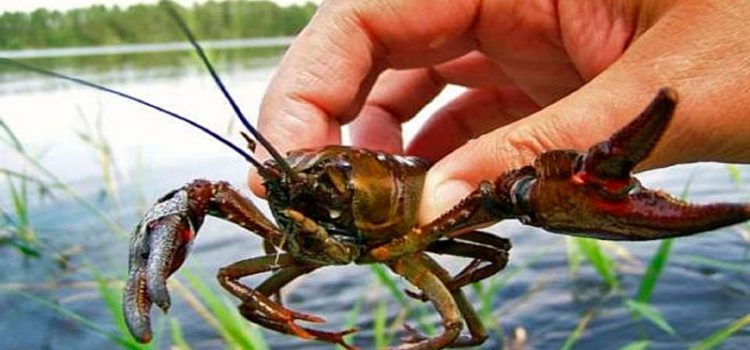
Cancer (Astacus astacus), or common crayfish, belongs to the order of decapod crustaceans (Decapoda). The front pair of limbs is highly developed and ends with claws, with which the crayfish grabs prey and defends itself. The next four pairs of less developed limbs are for locomotion. Under the tail shell are five more pairs of short, atrophied limbs. The anterior pair is developed in males into long tubular genitals. In females, the corresponding limbs are almost completely atrophied. The sex of young crayfish can be visually established only by the presence or absence of tubular genital organs. The sex of adult crayfish is easier to determine by comparing their claws and tails: male claws are larger, and the female’s tail is wider than that of an individual of the opposite sex. The broad tail of the female protects the eggs while they develop under the tail, attached to short limbs. The genital opening in females is located at the base of the third pair of limbs, and in males – at the base of the fifth pair of limbs.
Habitat and lifestyle
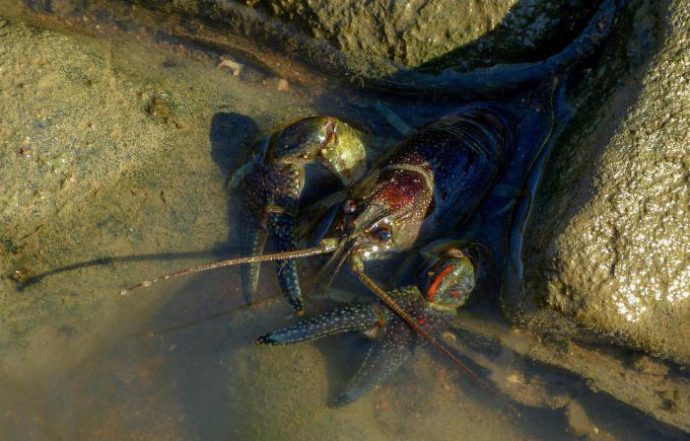
Cancers are more whimsical in relation to the environment than many people think. The water where they live must be fresh; crayfish cannot breed in salty or salty-fresh sea water. The content of oxygen in the water crayfish need the same as salmon fish. For a normal life of crayfish in the warm season, the water must contain oxygen over 5 mg / l. Crayfish can live in both light and dark water, as long as it does not have too much acidity. The pH value of water ideal for the life of crayfish should be above 6,5. The growth of crayfish in lime-depleted waters slows down. Crayfish are very sensitive to water pollution. If the living conditions are favorable, then crayfish can live in a variety of fresh water bodies – lakes, rivers, oxbow lakes and streams. However, it seems that the favorite habitat of crayfish is still rivers.
In habitats of crayfish, the bottom of the reservoir should be solid and without silt. On a muddy bottom, as well as on rocky or sandy shores, as well as in shallow water with a flat, clean bottom, crayfish are not found, since they cannot find shelter for themselves or dig it out. Crayfish love rocky bottoms where they can easily find shelter, or bottoms suitable for burrowing. Crayfish burrows are found in coastal pits or in the slopes of the coast. Most often they are located on the border of hard and soft bottom. The exit from the hole, the corridor of which can be more than a meter long, is usually hidden under the trunk of a fallen tree, tree roots or under stones. The crayfish hole is quite close, dug according to the size of the inhabitant, which makes it easier for the crayfish to organize protection from the attack of larger brothers. Cancer is difficult to pull out of the hole, he tenaciously clings to its walls with his limbs. That the burrow is inhabited is shown by fresh soil at the entrance. Cancer lives at a depth of 0,5 to 3,0 m. The best places for housing are captured by large males, less suitable ones remain for weak males and females. Juveniles stay in shallow water near the coastline itself, under stones, leaves and twigs.
Cancer in its way of life is a hermit. Each individual has some kind of shelter that protects from relatives. During daylight hours, the crayfish is in a shelter, closing the entrance to it with claws. Sensing danger, he quickly backs away, going deeper into the hole. The crayfish goes out to search for food at dusk, and in cloudy weather – in the afternoon. It usually moves in the water at night with its claws extended forward and its tail held straight, but if frightened, it will quickly swim back with strong tail blows. It is generally believed that cancer stays in one place. However, after a few weeks, tagged crayfish fall into gear hundreds of meters from the places where they were tagged.
Growth

The growth rate of crayfish depends primarily on the temperature and composition of the water, the availability of food and the density of crayfish in the reservoir. Growth rates of crayfish in different reservoirs are different. But even in one reservoir year after year is not necessary, much depends on the temperature of the water. In the first and second summers of life, males and females have the same growth rate, but at the end of the third summer, or second year of life, males are on average already larger than females. In the conditions of southern Finland, crayfish reach 1,4–2,2 cm in length by the end of the first summer, 2,5–4,0 cm by the end of the second summer, and 4,5–6,0 cm by the end of the third summer. the size allowed for catching (10 cm) is reached by males at 6-7 years of age, females at 1-8 years of age. In waters with enough food for crayfish and under other favorable conditions, crayfish can reach the sizes allowed for fishing two years earlier than the indicated period, but under unfavorable conditions – several years later.
People often ask how big crayfish can grow. Fisheries adviser Brofeldt in 1911 noted that in the town of Kangasala there were specimens 16-17 cm long, although then such crayfish were caught less and less. Suomalainen reported that the 1908-12,5 cm long crayfish caught in 13 were medium-sized specimens. These testimonies seem like fairy tales to us – crayfish do not have to be so large. In 1951, the Seura magazine was the organizer of the competition – who will catch the largest crayfish during the summer. The winner was the competitor who caught the crayfish 17,5 cm long, up to the tip of the claw – 28,3 cm, weighing 165 g. The crayfish had only one claw, which explains its relatively low weight. It can be considered a surprise that the female turned out to be a giant cancer. In second place was the male, whose length was 16,5 cm, and to the tips of the claws – 29,9 cm. This specimen weighed 225 g. Other examples of caught crayfish 17,0-17,5 cm long are known from the literature. It is interesting to note that, according to the Estonian scientist Järvekulgin, male crayfish over 16 cm long and weighing 150 g, and female crayfish over 12 cm long and weighing 80-85 g, are exceptionally rare. Obviously, a female caught in Finland in 1951 can be considered a giantess.
What about the age of the crabs? How long do crabs live? So far, there is no sufficiently accurate method for determining the age of crayfish, similar to how the age of a fish is determined. The life expectancy of individuals of crayfish is forced to be determined by comparing age groups or groups of crayfish of the same length. Because of this, it is impossible to accurately determine the age of single large specimens. There is information in the literature about cancers reaching 20 years of age.
Molting
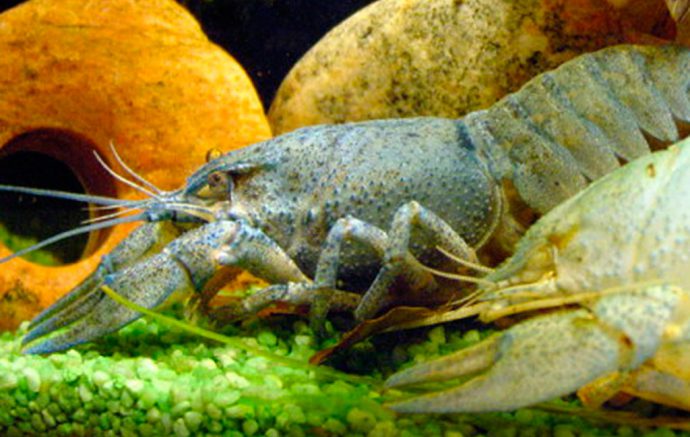
Crayfish grow, as it were, in leaps and bounds – when replacing the shell. Molting is an important moment in the life of crayfish, at this time there is a thorough renewal of their organs. In addition to the chitinous cover, both the upper layer of the retina and gills, as well as the protective upper layer of the oral appendages and parts of the digestive organs, are updated. Before molting, the crayfish hides for several days in its hole. But the molt itself takes place in an open place, and not in a hole. Replacing the shell takes only about 5-10 minutes. Then the defenseless cancer is clogged for a week or two, during the hardening of the shell, in a shelter. At this time, he does not eat, does not move, and, of course, does not fall into gear.
Calcium salts come from the blood into the new shell and impregnate it. Before molting, they accumulate in two oval solid formations found in crayfish in the stomach. Sometimes when eating cancer, they can be detected.
Moulting occurs only in the warm season. In the first summer of life, cancer molts 4-7 times, depending on growth conditions, in the second summer – 3-4 times, in the third summer – 3 times and in the fourth summer – 2 times. Adult males molt 1-2 times a season, and females that have reached puberty, as a rule, once. Closer to the northern border of the distribution of crayfish, some females molt every second year.
The molting of males, as well as females that do not have eggs under their tails, occurs at the end of June; females carrying eggs – only when the larvae come out of the eggs and separate from the mother. In the south of Finland, such females usually change their shell in early July, and in the north of Finland, their molt passes into August.
If the beginning of summer is cold, the molt may be several weeks late. In such cases, when the fishing season begins (from July 21), the shell may not yet harden, and the crayfish will not fall into gear.
Reproduction
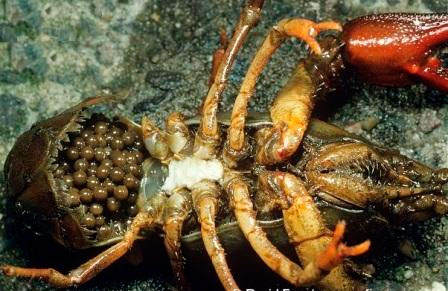
Male crayfish reach sexual maturity at about 6-7 cm, females – 8 cm. Sometimes there are females 7 cm long, carrying eggs under their tails. Males in Finland reach sexual maturity at 3-4 years (corresponding to 4-5-year seasons), and females at 4-6 years (corresponding to 5-7-year seasons).
Sexual maturity of a crayfish can be determined by gently lifting its dorsal shell. In a male who has reached puberty, curls of white tubules are visible in the tail under a thin “skin”. The white color of the tubules, which are sometimes mistaken for parasites, is due to the liquid in them. Under the shell of the female, eggs are visible, which range from pale orange to brown-red, depending on the degree of their development. The puberty of the female can also be determined by the white streaks running across the lower tail carapace. These are mucous glands that secrete a substance with which the eggs are then attached to the tail limbs.
Crayfish mating occurs in autumn, in September-October. Crayfish do not gather, like fish, for spawning grounds, their fertilization takes place in their usual habitats. The male turns the female onto her back with large claws and attaches the spermatophores at the female’s genital opening in the form of a white triangular spot. A few days later, or even weeks, the female, lying on her back, lays eggs. In Finnish conditions, the female usually lays from 50 to 1 eggs, and sometimes up to 50. The eggs do not separate from the female, but remain in the gelatinous mass secreted by her glands.
Under the tail of the female, eggs develop until the beginning of the next summer. During the winter, the number of eggs is significantly reduced due to mechanical loss and fungal infection. In the southern part of Finland, the larvae hatch in the first half of July, in the northern part of the country – in the second half of July, depending on the water temperature at the beginning of summer. The larvae are already 9-11 mm long when they emerge from the eggs and are very similar to small crayfish. But their back is more convex and relatively wide, and the tail and limbs are less developed than in young crayfish. The larvae stay for about 10 days under the mother’s tail until they suck out the transparent reddish yolk to the end. After that, they are separated from their mother and begin an independent life.
Food
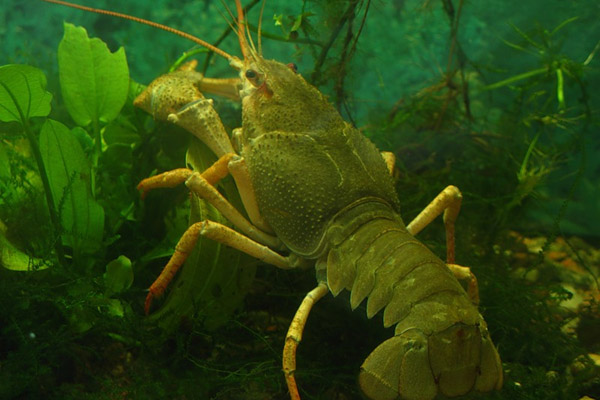
Cancer – an omnivore. It feeds on plants, benthic organisms, devours even relatives, especially those that molt or have just shed and are therefore defenseless. But the main food is still vegetable, or rather, in the first years of life, the crayfish feeds more on bottom organisms and gradually switches to plant food. The main food is insect larvae, especially twitching mosquitoes, and snails. First-year-olds willingly eat plankton, water fleas, etc.
Cancer does not kill or paralyze its prey, but, holding it with claws, gnaws it, biting off piece by piece with sharp parts of the mouth. A young cancer can eat a mosquito larva several centimeters long for about two minutes.
There is an opinion that cancer, eating caviar and fish, harms the fish industry. But this information is based more on assumptions than facts. As early as the beginning of the current century, T. X. Yarvi pointed out that in those reservoirs where crayfish were introduced, the number of fish did not decrease, and in reservoirs in which the plague destroyed the crayfish, the number of fish did not increase. None of the 1300 crayfish caught by research from the two rivers ate fish, although there were many of them and the most diverse ones. It’s not that cancer but can catch fish. His slow movements are deceptive, he is able to quickly and accurately grab prey with claws. An insignificant part of the fish in the diet of crayfish is apparently due to the fact that fish simply do not swim close to the habitats of crayfish. Inactive, sick or injured fish, cancer, of course, is able to eat in large quantities and effectively cleans the bottom of the reservoir from dead fish.
Enemies of crayfish

Cancer has many enemies among fish and mammals, although it is well protected by a shell. Eel, burbot, perch and pike willingly eat crayfish, especially during their molt. The eel, which can easily penetrate the crayfish hole, is the most dangerous enemy of large individuals. For young crustaceans living in coastal waters, the most dangerous predator is perch. Larvae and juveniles of crayfish are also eaten by roach, bream and other fish that feed on bottom organisms.
Of the mammals, the most famous enemies of crayfish are the muskrat and mink. At the feeding places of these animals, near the shores of reservoirs, you can find quite a lot of their food waste – crustacean shells. And yet, most of all, it is not fish and mammals that destroy crayfish, but crayfish plague.
catching crayfish
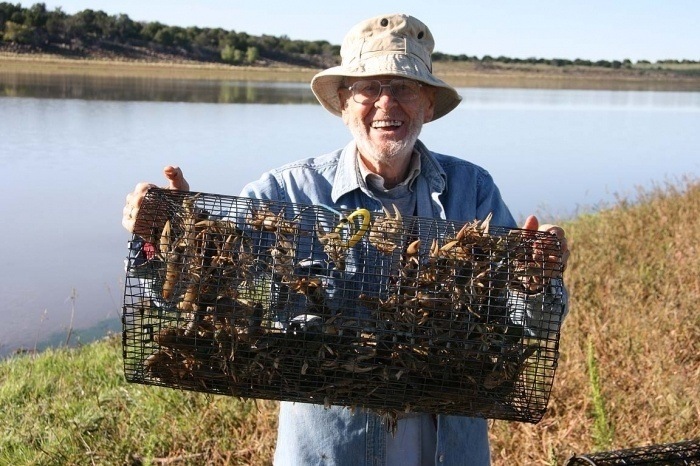
It is known that crayfish were caught already in ancient times. Until the Middle Ages, they were used for medicinal purposes. The ashes of the burned crayfish were advised to sprinkle the wounds from the bites of a rabid dog, a snake and a scorpion. There are boiled crayfish were also prescribed for medicinal purposes, for example, with exhaustion.
From historical literature it is known that at the royal court of Sweden already in the XNUMXth century. gave a worthy assessment of the taste of crayfish. Naturally, the nobles in Finland began to imitate the royal nobility. The peasants caught and delivered crayfish to the nobles, but they themselves treated the “armored beast” with great distrust.
The crayfish fishing season in Finland starts on July 21 and continues until the end of October. Starting from the second half of September, catches are reduced. In practice, catching crayfish is stopped a few weeks before the ban, because in late autumn the meat of the crayfish loses its taste, and the shell becomes harder and harder.
Crayfish catches at the beginning of the season depend primarily on water temperature. If May and June are warm and the water temperature is high, then the molting of both males and females ends before the onset of the fishing season. In this case, the catches are good from the very beginning. In cold summers, molting may be late, and crayfish begin to move after hardening of the shell only at the end of July. As a rule, in the south of Finland at the beginning of the season, crayfish are always caught better than in the north, where the molting of crayfish takes place later.
Fishing methods and gear
In connection with the expansion of fishing with netting, other methods of catching crayfish remain in the background or are completely forgotten. And yet, crayfish can be caught in many ways, which are not so easy, but are excitingly interesting for amateurs.
Catching with hands

Catching crayfish with your hands is the most primitive and, apparently, the most ancient way. The catcher moves carefully in the water and looks under the stones, tree trunks, lifts the branches under which the crayfish hide in the daytime. Noticing the cancer, he tries to grab it with a quick movement until he hides in a shelter or runs away. Naturally, this fishing method is not suitable for those who are afraid of claws. The biggest catch happens in the dark, when crayfish that have left their shelters can be caught by illuminating the bottom of the reservoir with a lantern. In the old days, a fire was lit on the shore to lure crayfish. In such a simple way, near the shore on a rocky bottom, where there are many crayfish, you can catch hundreds of them.
You can grab a crayfish with your hands only if the water depth is not more than 1,5 m. For catching crayfish in deeper waters, and in reservoirs with clear water at a depth of even several meters, so-called crayfish mites were used in Finland. These wooden pincers easily catch and lift crayfish out of the water. Ticks can be from one to several meters long. To prevent mites from damaging the cancer, they can be made hollow.

A simpler device is a long stick, at the end of which a split is made, and it is expanded with a small stone or wooden stick. It is impossible to pull the crayfish out of the water with such a stick, it is only pressed to the bottom and then raised by hand. Catching with ticks requires great skill, since crayfish, as soon as they sense danger, run away very quickly. Due to their own sluggishness, the Finns did not widely use ticks as a fishing tool, and they were not widely used. The unpopularity of this method of fishing,. apparently, it is also connected with the fact that in the dark waters of Finnish reservoirs it is difficult to notice cancer, and if a reservoir is a little deeper than a very shallow one, then it is completely impossible to see it.
Underwater fishing also belongs to this method of harvesting crayfish. It requires special goggles and a breathing tube. Crayfish from holes can be pulled out with gloved hands or collected from the bottom at night. When diving at night, you must have a flashlight, or a partner must illuminate the bottom from the shore or boat. Although the diver catches close to the shore, various dangers always lie in wait for him. Therefore, it is recommended that a partner be on duty on the shore and observe the progress of fishing.
An example of catching hands underwater — Video
Underwater Hunting for Crayfish. Spearfishing on Сrayfish.
Fishing crayfish
With the considered fishing methods, baits are not used at all. The catch when fishing without baits always depends on chance, and there is no guarantee that you will catch crayfish. With the use of baits, fishing becomes more effective. The bait attaches the crayfish to the gear and keeps it in the places of catching.
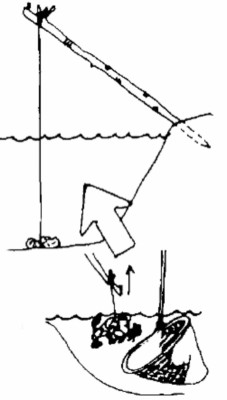 Crayfish gathered around the bait can be taken with your hands or with a net. But a more “improved” method of fishing is fishing, in which the crayfish clings to a bait tied to the end of a fishing line or the base of a stick, and holds on to the bait until it is picked up with a net and pulled out of the water. Crayfish fishing differs from fish fishing in that they do not use hooks and the crayfish can unhook at any time.
Crayfish gathered around the bait can be taken with your hands or with a net. But a more “improved” method of fishing is fishing, in which the crayfish clings to a bait tied to the end of a fishing line or the base of a stick, and holds on to the bait until it is picked up with a net and pulled out of the water. Crayfish fishing differs from fish fishing in that they do not use hooks and the crayfish can unhook at any time.
A fishing line is tied to a stick 1-2 m long, and a bait is tied to the fishing line. The pointed end of the stick is stuck into the bottom of a lake or river near the shore or into the coastal slope. The bait is placed in the right place to graft cancer.
The catcher can simultaneously use several, even dozens, fishing rods. Their number depends primarily on the density of crayfish in the reservoir, the activity of their zhora and the supply of nozzles. According to the Swedish researcher S. Abrahamsson, the attachment attracts crayfish in stagnant water from an area of about 13 sq.m. Therefore, it makes no sense to place gear more often than at a distance of 5 m from each other and no closer than 2,5 m from the coastline. Usually, rods are stuck at a distance of 5-10 m from one another, in more catchy places more often, in less catchy places – less often.
During the evening and night, depending on the zhor, the fishing rods are checked several times, sometimes even 3-4 times per hour. The fishing area should not exceed 100-200 m in length, so that you can check the fishing rods in time, until the crayfish have time to eat the bait. If during the evening the catch decreases, you need to move to a new place. When checking the fishing rods, the stick is carefully pulled out of the bottom and the fishing rod is lifted so slowly and smoothly that the crayfish clinging to the bait does not unhook, but rises with it closer to the surface of the water, where the prey is carefully picked up from below with a net lowered into the water. Fishing can be very productive. Sometimes 10-12 crayfish can be pulled out at a time. The swaying end of the stick, to which the fishing line is tied, shows that the crab has attacked the bait,
Zakidushka and zherlitsa are the same type of tackle with a fishing rod. They usually tie a bait to a 1,5-meter length of fishing line, and a float to the other end. A sinker is tied to the vent next to the bait.
The so-called crayfish stick differs from a fishing rod in that a short piece of fishing line is tied to the stick or the fishing line is not used at all. In this case, the bait is attached directly to the lower end of the stick. The stick is stuck into the bottom at the fishing area in such a way that the bait is lying freely on the bottom.
The technique of catching with a hook, zherlitse and a crayfish stick is the same as catching with a fishing rod. They fish crayfish with all these gear in the same way as fish. The angler keeps the rod in his hands all the time and, feeling that the crayfish has grabbed the bait, carefully pulls it along with the bait to the surface of the water, closer to the shore, and with his other hand puts the net under the crayfish. In this way they catch, for example, in France – there a ring is tied to the end of the fishing line to thread the bait into it.
Racevni
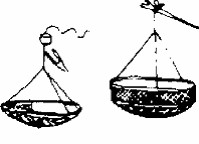 Rachevni are now widely used. Rachevnya is a cylindrical mesh stretched over a metal round hoop. Hoops are currently made from galvanized wire. Previously, they were made from willow or bird cherry twigs, and a stone, piece of iron or a bag of sand was tied in the center of the grid for pulling. The diameter of the hoop is usually 50 cm. Three or four thin cords of the same length are tied to the hoop at an equal distance in order to avoid warping the crust, and connect them with a common knot, into the loop of which a stronger cord is threaded for lowering and raising the gear. If caught from the shore, the cord is attached to the pole. The bait is tied to a net, to a cord stretched along the diameter of the hoop or a thin stick, also attached to the hoop, and the trap is lowered to the bottom. The cord for pulling out the crustacean is tied to a buoy or a pole stuck into the slope of the shore. Fishing for crabs is based on the fact that a crayfish, clinging to the bait, cannot get out of the trap when it is lifted out of the water. Rachevny should not hesitate to raise. At the same time, it is possible to fish with several rachovni, placed from each other at a distance of 5-10 m.
Rachevni are now widely used. Rachevnya is a cylindrical mesh stretched over a metal round hoop. Hoops are currently made from galvanized wire. Previously, they were made from willow or bird cherry twigs, and a stone, piece of iron or a bag of sand was tied in the center of the grid for pulling. The diameter of the hoop is usually 50 cm. Three or four thin cords of the same length are tied to the hoop at an equal distance in order to avoid warping the crust, and connect them with a common knot, into the loop of which a stronger cord is threaded for lowering and raising the gear. If caught from the shore, the cord is attached to the pole. The bait is tied to a net, to a cord stretched along the diameter of the hoop or a thin stick, also attached to the hoop, and the trap is lowered to the bottom. The cord for pulling out the crustacean is tied to a buoy or a pole stuck into the slope of the shore. Fishing for crabs is based on the fact that a crayfish, clinging to the bait, cannot get out of the trap when it is lifted out of the water. Rachevny should not hesitate to raise. At the same time, it is possible to fish with several rachovni, placed from each other at a distance of 5-10 m.
How and where to catch crayfish

To catch crayfish were good, you need to know how and where to catch them. The mobility of crayfish depends on the illumination of the water. In dark waters that do not transmit light well, tackle can be placed early in the evening, sometimes as early as 15-16 hours. The richest catch in such waters is in the evening, and by midnight it decreases, as the activity of crayfish decreases. In clear waters, you should not start catching crayfish before evening, the catch continues to grow until midnight and even after midnight. After the darkness of the night, a new zhor is noted, but it is weaker than the evening one.
Many other factors also influence the activity of crayfish movement. In cloudy weather, fishing can be started earlier than in clear weather. The best catches of crayfish are on warm, dark nights, as well as in rainy weather. Catches are poorer on cold foggy and bright nights, as well as under the moon. Interfere with fishing and thunderstorms.
Traps are usually set at a depth of 1-XNUMXm, but if the vegetation eaten by crayfish and the bottom suitable for their habitat are in deeper places, you can try to catch at a depth of several meters. Crayfish stay deeper in light water than in dark water. It is best to catch them in reservoirs with a rocky or pebble bottom, at abandoned stone piers, bridges, under snags, at steep banks and under the slopes of the coast from the bottom, suitable for digging holes.
At night, during catching, crayfish are not measured or sorted, because in the dark it takes a lot of time and slows down catching. Crayfish are collected in dishes with low, steep edges and a wide bottom so that they are not placed in a thick layer. There should be no water at the bottom of the dish.
It is very convenient to measure the length of the crayfish with a measuring stick, in which there is a recess in the shape of the back of the crayfish. The length of the stick is 10 cm. Young crayfish less than 10 cm in size are selected and released back into the water. They are recommended to be released into the water away from the place of fishing, so that they do not get caught again and are needlessly injured.
Storage and transportation of crayfish
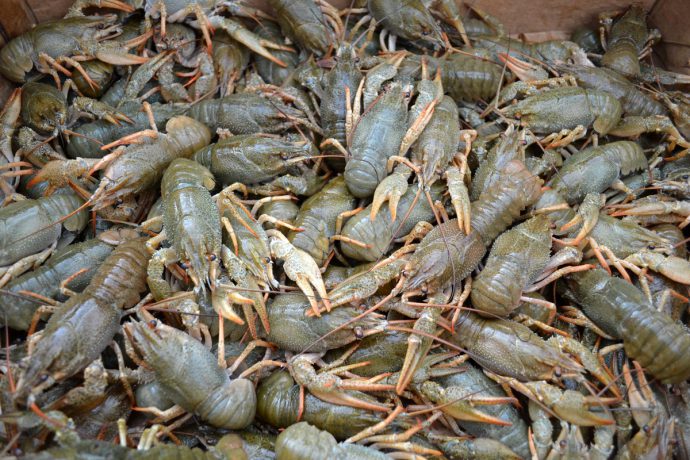
Most often, caught crayfish have to be stored for some time before consumption. They are usually kept in cages. It must be borne in mind that in order to localize possible infectious diseases, crayfish in cages should be kept in the water bodies from which they were caught. Low boxes made of boards, in the walls of which holes are drilled, or boxes with slots, have proven themselves best as cages. Crayfish are well preserved in cages made of wooden planks or metal mesh.
Crayfish should be kept in cages for as little time as possible, since they eat each other, especially helpless individuals. When storing crayfish for more than 1-2 days in cages, they must be fed so that they are better preserved and attack each other less. The usual food is fresh fish. Crayfish can also be fed nettles, alder leaves, potatoes, pea stalks, and other plant foods. It has been observed that crayfish fight more often for fish than for plant food. In these fights, they lose their claws and suffer other injuries. To avoid this, it is better to feed crayfish with vegetable food in cages.
Crayfish are usually transported without water, in spacious boxes. Wicker baskets are especially practical, as are wooden, cardboard and plastic boxes, as long as they have enough air holes.
Crayfish are placed in boxes about 15 cm high in only one row. On the bottom of the boxes, as well as on top of the crayfish, it is recommended to lay a layer of wet moss, grass, nettles, aquatic plants, etc. In higher boxes, intermediate shelves are made of slats so that the layers of crayfish do not fit tightly to each other. They can be transported safely and without intermediate partitions, having shifted layers of wet moss. Put the crayfish in boxes and cover them with moss as quickly as possible before they start to move. If the crayfish begin to show activity, they will quickly cluster in heaps in the corners of the box. Care must be taken so that the crayfish are not covered with water that has collected at the bottom of the box.
When transporting crayfish in the summer heat, care must be taken that the temperature in the boxes does not rise too high. To do this, you need to cover the boxes from direct sunlight, put ice bags around the boxes, etc. In the heat of crayfish, it is better to transport at night. To maintain the desired temperature inside, the boxes can be upholstered on the outside with any dry material.
On the recommendation of the Germans, crayfish should dry for half a day after being caught before being placed in boxes. There is also an opinion that crayfish tolerate transportation better if they have not received food for some time before.
The main activities for the care of crayfish in natural reservoirs are: – elimination of cancer diseases, especially cancer plague; — compliance with the recommendations for catching crayfish; – transplantation of crayfish; — reducing the number of weed species in the reservoir; – improving the habitat of crayfish.
The duty of every crayfish lover is to contribute to the localization of the epidemic, to prevent it from spreading widely, to follow the recommendations developed for these cases.
Intensive crayfish fishing is one of the effective methods to increase the number of crayfish in a pond. Since crayfish reach sexual maturity already at a length of 7-8 cm, and the minimum size allowed for catching crayfish is 10 cm, mass catching crayfish will not damage their livestock in the reservoir. On the contrary, when large and slow-growing individuals that occupy the best habitats are removed from the reservoir, the reproduction of crayfish is accelerated. Females with eggs and crustaceans should be immediately released into the water.
Individuals 8-9 cm long, which have reached puberty, are suitable for resettlement. Settling should be done no later than in August, so that the crayfish have time to acclimatize in a new habitat before mating and the onset of winter.
Crayfish Catching — Video
We catch crayfish on the most effective crayfish









